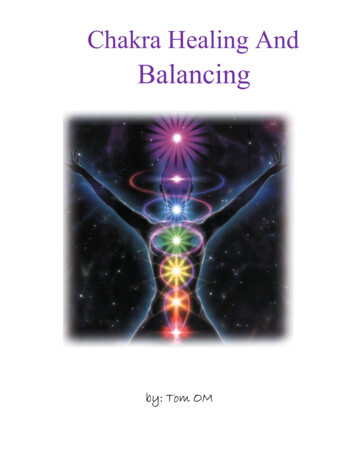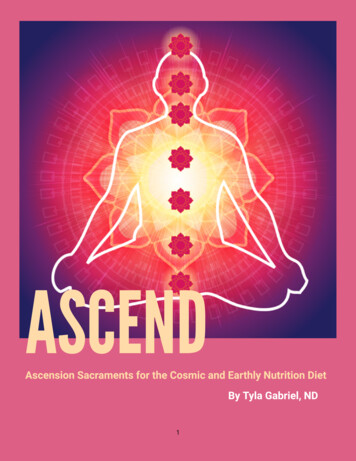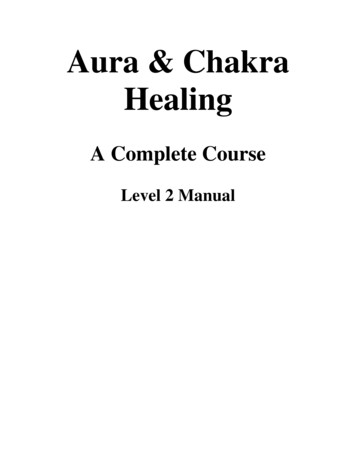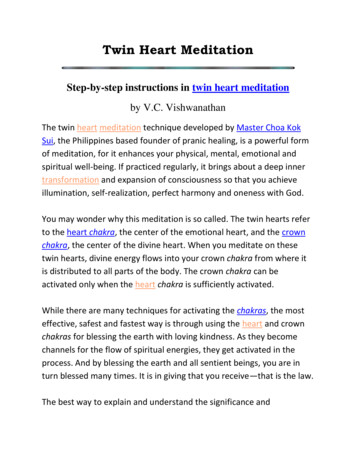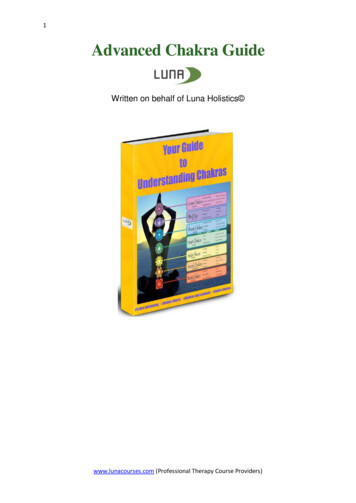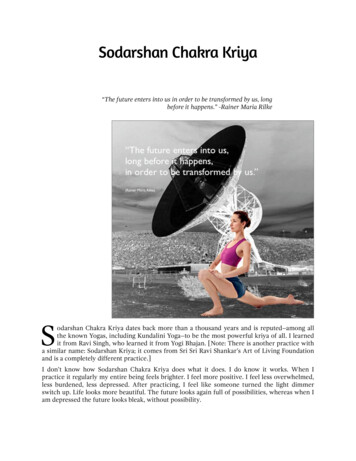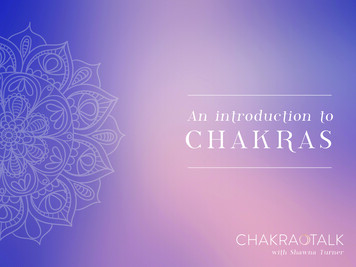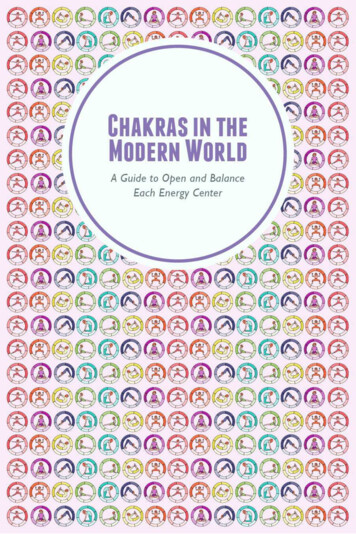
Transcription
The word “chakra”—and its sometimes hard-to-grasp meaning—may feelforeign or unapproachable to many of us. Though the history of chakrasspans centuries, the idea of balancing our seven main energy centers hasgained popularity in the hyper-connected smartphone era where work-lifebalance and taking time to focus on the self are often rarities. In this book,you’ll find a breakdown of each chakra, its corresponding colors, sounds, andemotions, and ways to tap into the key functions. Because chakra history isvast and there are varying beliefs about their complex nature (from origins tolegitimacy), we’re presenting this information as a broad overview—think of itas a beginner’s guide to balancing the chakras.1
Table of ContentsIntroduction — 3Chakra History — 5Root Chakra — 9Sacral Chakra — 12Solar Plexus Chakra — 15Heart Chakra — 18Throat Chakra — 21Third Eye Chakra — 24Crown Chakra — 27Conclusion — 302
IntroductionThe name chakra comes from the Sanskrit word for wheel, in referenceto the chariot wheels of rulers calledcakravartins (the original “cakra” waspronounced with a “ch,” but we usuallysee it written now as “chakra”). Energyfrom each these parallel points, calledchi, ki, or prana, is thought to flow in aspiral fashion so long as each chakra isopen. Other ancient eastern traditions,including pranayama, qi gong, acupuncture,and tai chi also focus on this flow calledpranic energy. Early mentions of chakrasdeem them the facilitators to a stable,more connected life (both to ourselvesand to others). By focusing on thesecenters and paying attention to theirspecific roles, it’s believed we can reachour highest potential. There are sevenmain chakras, each located at variouspoints along the spine. Some scriptural texts reference more, but we’llbe addressing the core seven.The seven chakras and their Sanskrit namesAs a junction of energy, thoughts, feelings, and the physical body, chakras havebeen called “focused energetic life-forces.” It’s thought if any of the chakras3
are blocked, individuals can develop physical and mental illnesses. Thoughchakras are rarely mentioned in Western medicine, many chakra punditsbelieve in their physiological merit. While the chakras are invisible, each islocated at a major network of arteries, veins, and nerves along the spine.Neurochemists have found a connection between the seven core chakrasand specific endocrine glands with nearly identical functions and descriptions(such as the thyroid and the throat chakra). It’s pretty remarkablehumans had a confident sense of these points thousands of years agobefore knowledge about the central nervous system was fairly common.4
There are many interpretations of both the meaning and history of thechakra system. Chakras are referenced in new age yoga classes on a regularbasis, but they’re nothing new. Spawning from ancient tradition, chakras werelikely spoken of far before they were scrawled on paper. It’s believed yogawas created around the chakras with the goal of balancing both the mindand body. Much like its circular namesake, countless people are circlingback to this ancient philosophy to manage demanding lives. Today, manyof us lead fast-paced lifestyles. With a changing outlook toward holistichealth, people continue to turn to alternative medicine for a lessinvasive way to reduce stress, gain spirituality, and manage emotional andphysical imbalances.Chakra TimelineMore than 2000 years agoChakras first referenced in ancient Hindu texts called theVedas (oldest written tradition in India).200 BCChakras described in the Yoga Sutras of Patanjali(a compilation of yoga teachings and philosophies).6
600 ADChakras described in the Yoga Upanishads (a collectionof texts with some of the first references of Hindu,Buddhist, and Jain beliefs).10th centuryPadaka-Pancaka written with descriptions of the chakras andtheir functions, Gorakshashatakam written with instructionsfor meditating on the chakras.1577Sat-Cakra-Nirupana written with descriptions of thechakras and their functions.1919Chakras introduced to the Western world by EnglishmanArthur Avalon in the book “The Serpent Power,” atranslation of Padaka-Pancaka and Sat-Cakra-Nirupana.1960sInterest in Eastern spirituality and healing gained steam in theWestern world, bringing with it a new, accepting attitudetoward the chakra system.TodayModern society continues to open up to alternative medicine.The ChakrasBeyond a corresponding color and sound (one-syllable vibrations, called Bijamantras, said to resonate with the energy of each location), the chakras havekey associations to certain emotions, instincts, and principles. Even-numberedchakras are linked with stereotypically feminine qualities, including opennessand compassion.The odd-numbered chakras are associated with masculinecharacteristics such as willpower and asserting oneself.It’s believed chakras are influenced by our thoughts and the environment,7
but also by the state of other individuals’ chakras. Each chakra then affectsdifferent parts of the body. Just like our internal organs have specificfunctions—such as the heart pumping blood through the body—thechakras are thought to have physical functions. The lower six chakrashelp enable cognition, respiration, circulation, digestion, reproduction, andexcretion. Channels, called meridians or nadis, connect the chakras toone another and help the prana (or chi or ki) travel through the chakras.Energy imbalances in a person’s chakras can relate to specific emotions,disease symptoms, or other ailments.There are plenty of holistic practitioners who specialize in chakrabalancing, but there are other beginner-friendly ways to work on them athome. Many natural health stores and online retailers offer chakra-specificproducts for aroma, sound, sensory, and color therapies. Practicingcertain asanas (or yoga poses or routines) can also release blocks andhelp remedy deficient or overloaded chakras. With each chakra, we’veincluded corresponding asanas, colors, affirmations, crystals, essential oils,and healing foods. Remember to begin working on the root chakrathen move your way up to the crown chakra.Note It’s always a good idea to start out with a meditation or yoga instructorfor guidance before starting on your own.8
Chakra oneThe root chakra is oriented to self-preservation. It’s related to the earth,stability, vitality, survival instincts, a sense of grounding, and a connection toour physical bodies. It brings us health, prosperity, security, and dynamic presence.Effects of imbalancesThe root chakra controls the adrenal glandand excretion system and is connected tothe bones, nails, gonads, anus, rectum, colon,prostate gland, and blood. A deficiency in orblockage of this chakra can lead to anxiety, fearof rejection, feeling run-down and sick, kneepain, sciatica, and constipation.Opening and balancingBalancing theroot chakra is allabout groundingand stabilizing. Toreduce the anxiety often associated with animbalance in this chakra, it’s important to taketime for yourself. Spend a few minutes outside,organize your home, spend a little more timepreparing a nutritious meal, or invest some timein something that makes you happy and at ease.Power activates this chakra.10
ColorEnvision the color red glowing at the base ofthe spine grounding you to the earth.Affirmations“I am peaceful, protected, and secure,” “I amsafe always, I am loved,” “I love my body.”CrystalsSmoky quartz, ruby, onyx,garnet, hematiteEssential oilsCedarwood, patchouliHealing foodsRed-colored foods including beets and apples, hot spices like cayenne pepper,root vegetables, animal proteins11
Chakra twoThe sacral chakra is related to water, emotions, sexuality, self-gratification,emotional identity, purity, joy, receptivity to nature, and feminine principle. Itconnects us to others through feeling, desire, sensation, and movement. Itbrings us fluidity and grace, depth of feeling, sexual fulfillment, and the abilityto accept change.Effects of imbalancesThe sacral chakra controls the testes, ovaries,and reproductive system and is connected to thepelvis, kidneys, production of adrenaline, womb,and bladder. A deficiency in or blockage of thischakra can lead to fear of pleasure, resistanceto change, a block in creativity, a sense ofdryness or emptiness, sexual problems ordiscomfort, hip, pelvic,and low back pain,urinary problems, andreproductive issues.Opening and balancingBalance this chakra through pampering andgetting in touch with your sexual and creativeself. Take a long bath, savor a sweet dessert, ordo something that makes you feel creative, likepainting or singing. Take pleasure in both sexualrelationships and regular, non-sexual facets ofyour daily routine. Purity activates this chakra.13
ColorEnvision the color orange glowing below thenavel energizing your pleasure center.Affirmations“I am a sensual, creative being,” “I am radiant andstrong,” “I feel comfortable with my sexuality.”CrystalsGolden topaz, citrine, carnelianEssential oilsRose, jasmine, sandalwoodHealing foodsOrange-colored foods including oranges and tangerines, nuts14
Chakra threeThe solar plexus chakra (also known as the power or naval chakra) is relatedto fire, ego, identity, transforming knowledge, solar/cosmic force, will, selfdefinition, autonomy, metabolism, and masculine principle. It brings us energy,effectiveness, spontaneity, and non-dominating power.Effects of imbalancesThe solar plexus chakra controls the pancreasand digestive system and is connected to thelower back, liver, spleen, gall bladder, pancreas,and the production of insulin. A deficiency in orblockage of this chakra can lead to frustration,powerlessness, low self-esteem, eating disorders,digestive problems, stomach ulcers, pancreas andgallbladder issues, high blood pressure, diabetes,liver dysfunction, andcolon diseases.Opening and balancingThe purpose of thesolar plexus chakra is to transform and honein on the ability to express intentions andhonesty. Spend some time assessing shortterm goals and long-term aspirations. Laugh offflaws and try not to take things too seriously.Happiness activates this chakra.16
ColorEnvision the color yellow glowing between thenavel and the rib cage, making you stronger andmore connected.Affirmations“I like my power and abilities,” “I am empoweredin everything I do,” “I trust my own guidance.”CrystalsSunstone, yellow citrine, aventurine quartzEssential oilsYlang ylang, bergamotHealing foodsYellow-colored foods including bananas and corn, grains, tea17
Chakra fourThe heart chakra is related to air, social identity, balance, unconditionallove, self-acceptance, compassion, and healing. It integrates opposites in thepsyche: mind and body, male and female, persona and shadow, ego and unity.It allows us to love deeply, feel compassion, and have a deep sense of peaceand centeredness.Effects of imbalancesThe heart chakra controls the circulatorysystem and thymus gland and is connected tothe heart, upper back, breasts, lungs, blood, andair circulation. A deficiency in or blockage ofthis chakra can lead to loneliness, a sense ofalienation, asthma, heart disease, high bloodpressure, lung disease, heart disease, and upperback, shoulder, arm, and wrist pain.Opening and balancingThe heart chakra’s focus is to become open tolove and compassion, both to yourself and thosearound you.Tell those you love that you lovethem without expecting anythingin return.Think of it literally:Watch a romantic movie or reada love story. Since this chakraalso encompasses the lungs, takebreaks throughout the day for deepbreathing. Selfless love activates thischakra.19
ColorEnvision the color greenglowing in the middle of yourchest allowing you to first loveyourself, then others.Affirmations“I completely love and accept myself,” “I understand my emotions,” “I giveand receive love unconditionally.”CrystalsGreen jade, green calcite, watermelon tourmaline, emerald, rose quartzEssential oilsRose, bergamotHealing foodsGreen-colored foods including leafy greens and vegetables, green tea20
Chakra fiveThe throat chakra is related to sound, creative identity, transmitting,communication, and creativity. It allows us to experience the worldsymbolically through vibration (such as the vibration of soundrepresenting language).Effects of imbalancesThe throat chakra controls the thyroid glandsand is connected to the throat, neck, thyroid andparathyroid glands, ears, windpipe, and the upperpart of the lungs. A deficiency in or blockageof this chakra can lead to anxiety over others’reactions to our views, self-censorship, a fear ofspeaking, neck stiffness, teeth grinding, laryngitis,ulcers, and an underactive thyroid.Opening and balancingBalancing the throatchakra requiresawareness of theway we express ourselves. Finding equilibriumbetween clear communication and knowingwhen to listen can improve the state of thischakra. Practice saying what you want beforeentering a stressful situation. Peace activatesthis chakra.22
ColorEnvision the color blue glowing in the middle ofthe throat increasing your ability to communicate.Affirmations“My thoughts are positive and truthful,”“I communicate with clarity and ease,”“I improve my communication every day.”CrystalsTurquoise, sodalite, celestite, aquamarineEssential oilsChamomileHealing foodsFresh juice, tea, all varieties of fruit23
Chakra sixThe third eye chakra (also called the brow chakra) is related to light, identity,insight, intuition, self-reflection, and the act of seeing–both physically andintuitively. It allows us to see clearly, letting us observe the big picture.Effects of imbalancesThe third eye chakra controls the brain and thepituitary gland and is connected to the face, nose,sinuses, ears, eyes, and brain functions that includethe pituitary gland, cerebellum, and central nervoussystem. A deficiency in or blockage of this chakracan lead to self-doubt,distrust, poor abilityto visualize, inabilityto remember dreams,decreased memory,headaches, sinus issues,seizures, hearing loss,and eye problems.Opening and balancingThis chakra calls for us to turn to our ownintuition for guidance. Work toward trustingthat little voice inside your head to decide whatthe next, best, most positive step is.Truth andknowledge activates this chakra.25
ColorEnvision the color indigo glowing in the middleof the forehead providing you focus and mentalclarity.Affirmations“I love my mind. It is strong and capable,” “I trustmy intuition,” “I am aware in every moment.”CrystalsFluorite, amethyst, azuriteEssential oilsRose, geranium, hyacinth, violetHealing foodsPurple-colored fruits including grapes and blueberries, chocolate, lavender26
Chakra sevenThe crown chakra is related to thought, universal identity, transcendence,wisdom, universal consciousness, and self-knowledge. It brings us knowledge,wisdom, understanding, spiritual connection, and bliss.Effects of imbalancesThe crown chakra controls the whole being andis connected to the cerebrum and pineal gland. Adeficiency in or blockage of this chakra can leadto depression, confusion, loss of faith, apathy,materialism and skepticism of spirituality orreligion, and sensitivity to light and sound.Opening and balancingTo balance the crownchakra, it’s importantto try and dim theconstant inner chatterin our heads and insteadbe present in the moment. If you’re open topraying, pray. Meditation is especially beneficial forbalancing this chakra. Bliss activates this chakra.ColorEnvision the color violet glowing on the top of thehead connecting you to the greater universe.28
Affirmations“I connect with spirit,” “I am who Iam,” “I choose to live my life from aplace of love.”CrystalsAmethyst, clear quartz, diamondEssential oilsLavender, rosewood, frankincenseHealing foods:The crown chakra benefits more from clean, fresh air than foods.29
ConclusionChakras are interconnected with one another. Reading about chakras isa great first step, but actually putting focus and awareness on healing ourenergy centers can bolster overall well-being. Devoting much of our daysto chakra balance through meditation, yoga, aromatherapy, praying, andaffirmations may not be realistic for everyone. But by becoming awareof these invisible chakras—and signs of an imbalance—we can try outnew methods of self-help beyond turning to things like food, alcohol, ormedication to tackle emotional and physical problems.Sources:Chakras: Balance Your Body’s Energy for Health and Harmonyyogajournal.com (and entre.co.ukBrought to you by:This ebook is brought to you by Health Perch. Health Perch, a digitalhealth magazine, focuses on physical and mental wellness, as well as waysto fight the signs of aging. We aim to make health and wellness easy tounderstand and fun to read about. Follow us on Facebook, Twitter, andPinterest for the latest health news.NorthWestPharmacy.com30
Essential oils Ylang ylang, bergamot Healing foods Yellow-colored foods including bananas and corn, grains, tea 17. Chakra four The heart chakra is related to air, social identity, balance, unconditional love, self-acceptance, compassion, and healing. It integrates opposites in the
